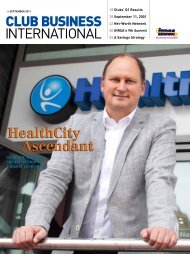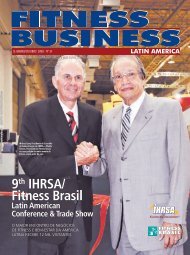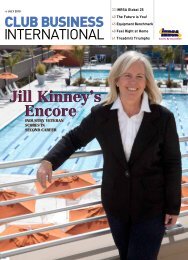Augie In Action! Augie In Action! - Ihrsa
Augie In Action! Augie In Action! - Ihrsa
Augie In Action! Augie In Action! - Ihrsa
Create successful ePaper yourself
Turn your PDF publications into a flip-book with our unique Google optimized e-Paper software.
IT MAY NOT BE WHAT MOST CLUB OPERATORS THINK OF AS A WELLNESS CENTER. Healthtrax<br />
Fitness and Wellness, a chain of medically-affiliated fitness centers based in Glastonbury,<br />
Connecticut, operates much like a traditional IHRSA club, with the same best-of-breed fitness<br />
equipment and programs that have become the industry standard.<br />
But what makes its locations special, what makes them different, is exactly that—their physical<br />
locations. They are not separate, free-standing clubs; they are designed as an integral piece of a healthcare<br />
community, well-positioned as part of a network of health and wellness practitioners of every<br />
sort and specialty, from major hospital partners to individual chiropractors, all in one location.<br />
The Healthtrax Fitness and Wellness model, which first emerged in Hanover, Massachusetts, in<br />
1990, is “a new breed of real estate,” explains Bob Stauble, the director of new business and sales<br />
for Healthtrax. “We’ve branded the building as a community wellness center. It’s a medical building<br />
that has a 35,000-square-foot fitness center as its anchor.”<br />
Eighteen years and 15 community wellness centers later, Healthtrax has perfected a formula that<br />
makes clever and effective use of medical affiliations, collective marketing, and strategic branding—<br />
resulting in high member retention, consistent profits, and continued growth.<br />
Wellness from the ground up<br />
<strong>In</strong> the 1980s, before the days of healthcare reform, hospitals were relatively well-funded and<br />
even expanded beyond their core businesses. <strong>In</strong> some cases, such as in the Chicago area, they<br />
built oversized health clubs on their medical campuses that performed quite well, when<br />
compared to other hospital departments. But the downfall of the now-defunct hospital fitness<br />
center model was that many of the institutions often applied their not-for-profit mentality to what<br />
most believe should be managed as a for-profit business.<br />
“The problem was that, in one example, they weren’t charging themselves rent, and they were just<br />
looking at net income, not EBITDA, not cash flow—so, while it appeared that they were generating a<br />
half a million dollars in profits, by IHRSA’s standards, they were actually losing money to the tune of a<br />
quarter-million dollars a year,” explains Stauble, who watched the phenomenon closely.<br />
It was during this period that Healthtrax, which had a handful of New England clubs in its<br />
portfolio, began to study the medical fitness model carefully, and its current business plan began<br />
to take shape. ><br />
By Jennifer H. Mc<strong>In</strong>erney<br />
Healthtrax has<br />
successfully forged a<br />
rewarding medical link<br />
www.ihrsa.org | MARCH 2008 | Club Business <strong>In</strong>ternational 85
















